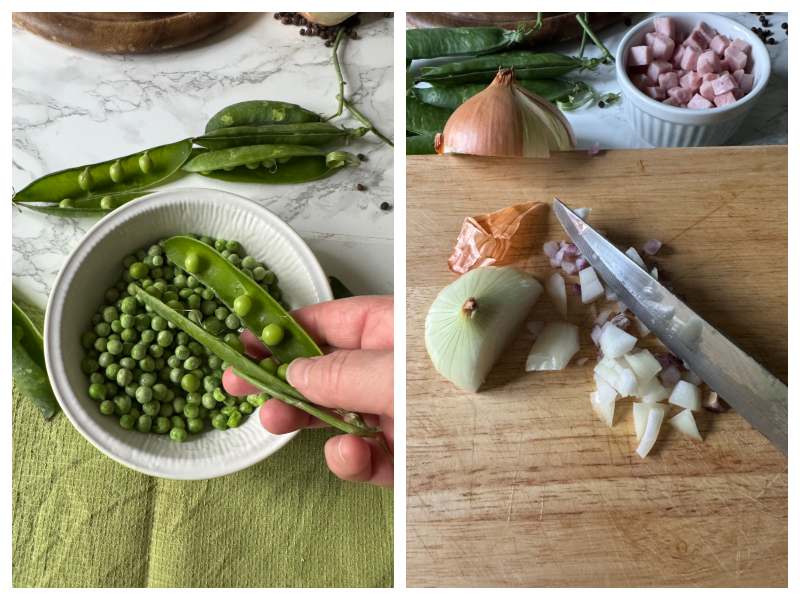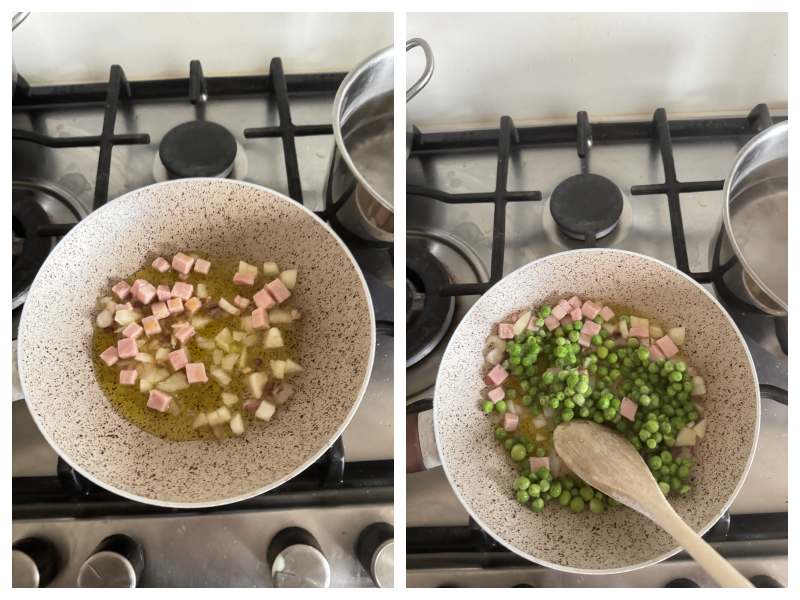Pasta e Piselli alla Napoletana (Neapolitan Pasta and Peas) is a classic dish from Campania, deeply rooted in Italian culinary tradition. This simple yet flavorful recipe is easy to make and incredibly satisfying.
Although pasta e piselli is often considered a spring dish, you can enjoy it year-round by using frozen peas. However, in spring, the flavor is even more vibrant with fresh, sweet, and tender peas.

This Neapolitan pasta e piselli has a unique texture, somewhere between a soup and a pasta dish—just like other traditional southern Italian recipes, such as pasta e patate. Depending on how much liquid you add, it can be more or less soupy.
This dish follows a one-pot cooking method, where you gradually add hot water as the pasta cooks. This technique creates a wonderfully creamy texture without needing additional dairy.
For the best results, use small pasta shapes like ditalini, tubetti, or Neapolitan mixed pasta. Broken spaghetti is another common choice in Naples.
Give this easy yet traditional pasta and peas Neapolitan style a try—it’s a comforting dish that brings the flavors of spring straight to your table!
Ingredients

Prep Time: 25 Min | Cook Time: 30 Min | Servings: 4
- 300 g (10 oz) of ditalini pasta (or any small pasta of your choice)
- 400 g (14 oz) of peas (fresh or frozen)
- 100 g (3.5 oz) of diced cooked ham or diced pancetta
- 1 medium onion
- 1-2 pieces of Parmigiano Reggiano rind
- 100 g (3.5 oz) of grated Parmigiano Reggiano
- salt, to taste
- freshly ground black pepper, to taste
- 1 liter (4 ¼ cups) of water (or hot vegetable broth)
- 4 tablespoons of extra virgin olive oil
Instructions

Step 1) - If you’re using fresh peas, start by shelling them and rinsing them under cold running water. If you’re using frozen peas, you can skip this step.
Next, heat 1 liter (4 ¼ cups) of water or vegetable broth in a small pot and keep it warm. This will be added gradually during cooking to achieve the perfect creamy consistency.
Peel and thinly slice the onion. Then, cut the ham or pancetta into small cubes.

Step 2) - In a large saucepan or deep skillet, heat 2–3 tablespoons of extra virgin olive oil over medium heat. Add the sliced onion and diced ham (or pancetta) and sauté until the onion turns soft and golden, and the pancetta is lightly browned.
Once the onion and pancetta are well sautéed, add the peas to the pan.

Step 3) - Stir with a wooden spoon to coat them in the flavorful base, then pour in a small amount of hot water or broth—just enough to cover them partially.
Season the mixture with fine salt and freshly ground black pepper to taste. Then, add 1–2 pieces of Parmigiano Reggiano rind.
TIP: If you’re using a whole piece of Parmigiano, first clean the rind by scraping off the outermost layer with the printed markings. Then, cut it into smaller pieces. During cooking, the rinds will soften and infuse the dish with deep umami flavor.
Cover the pan with a lid and let the peas simmer for about 20 minutes, allowing them to absorb all the flavors.

Step 4) - Once the peas are tender, add a little more hot water or broth to the pan and bring it to a gentle boil. Now, stir in the pasta.
To achieve the perfect creamy texture, cook the pasta in the same pan as the peas, gradually adding hot water or broth a little at a time whenever the mixture starts to dry out. Be careful not to add too much liquid at once—the dish should be creamy, not soupy. Stir occasionally to prevent sticking.

Step 5) - When the pasta is cooked al dente, turn off the heat and stir in 2–3 tablespoons of grated Parmigiano cheese. Taste and adjust seasoning if needed.
Serve immediately, finishing each plate with a generous sprinkle of black pepper and extra cheese.
Enjoy your homemade Pasta e Piselli alla Napoletana, a comforting dish packed with traditional Neapolitan flavors!

YOU MUST ALSO TRY:
- Pasta e Ceci (Italian Pasta and Chickpea Soup)
- Risi e Bisi (Authentic Venetian Rice and Peas)
- Risotto with Peas and Zucchini Flowers
- Pasta and Beans (Pasta e Fagioli)
Storage
Store pasta e piselli in an airtight container in the refrigerator for up to one day.
Freezing is not recommended for the complete dish, as the pasta may become too soft and lose its texture. However, if you used fresh peas, you can freeze them after cooking and use them later to prepare the dish fresh.
Tips and Variations
Like many traditional Italian recipes, Neapolitan pasta e piselli has numerous variations, influenced by family traditions and personal preferences. Each household in Naples has its own way of preparing this comforting dish, adapting it to different tastes and ingredients.
Meat Variations: Pancetta, Ham, or Smoked Pancetta - The classic recipe typically includes pancetta tesa, which adds a rich, savory depth to the dish. However, some prefer to substitute it with diced cooked ham for a milder flavor, while others opt for smoked pancetta for an extra layer of smokiness.
Vegetarian Pasta e Piselli: Egg and Cheese Variation - For a vegetarian version, you can replace the meat entirely. A traditional method used in some Neapolitan households involves adding a beaten egg mixed with grated cheese (such as Parmigiano Reggiano or Pecorino Romano) just before turning off the heat. Stirring it in while the pasta is still hot creates a creamy, velvety texture, similar to a carbonara-style finish.
Extra Creamy Pasta e Piselli: Blended Peas Method - If you love an ultra-creamy texture, try blending one-third of the cooked peas using an immersion blender. Then, mix this smooth pea purée back into the pot with the pasta. This technique enhances the dish’s creaminess without needing additional dairy, keeping it light yet silky.
Cheese Swap: Pecorino Romano for a Stronger Flavor - While Parmigiano Reggiano is the most commonly used cheese, you can achieve a bolder, saltier flavor by substituting it with Pecorino Romano. This aged sheep’s milk cheese adds a tangy, robust taste that pairs beautifully with the sweetness of the peas.
Aromatic Enhancements: Spices and Herbs - To elevate the dish with aromatic notes, consider adding a pinch of freshly grated nutmeg while cooking. This small addition enhances the warmth of the dish without overpowering its delicate flavors.
If you enjoy herbal flavors, try adding a few leaves of fresh thyme or lesser calamint (nepitella). These Mediterranean herbs infuse the dish with a slightly minty, earthy aroma, making it even more fragrant and flavorful.

Recipe Card

Pasta e Piselli alla Napoletana (Neapolitan Pasta and Peas)
Ingredients
- 300 g ditalini pasta - 10 oz, or any small pasta of your choice
- 400 g fresh or frozen peas - 14 oz
- 100 g diced cooked ham or diced pancetta - 3.5 oz
- 1 medium onion
- 1-2 pieces Parmigiano Reggiano rind
- 100 g grated Parmigiano Reggiano - 3.5 oz
- salt - to taste
- black pepper - to taste
- 1 liter water or hot vegetable broth - 4 ¼ cups
- 4 tablespoons extra virgin olive oil
Instructions
- If you’re using fresh peas, start by shelling them and rinsing them under cold running water. If you’re using frozen peas, you can skip this step.
- Next, heat 1 liter (4 ¼ cups) of water or vegetable broth in a small pot and keep it warm. This will be added gradually during cooking to achieve the perfect creamy consistency.
- Peel and thinly slice the onion. Then, cut the ham or pancetta into small cubes.
- In a large saucepan or deep skillet, heat 2–3 tablespoons of extra virgin olive oil over medium heat. Add the sliced onion and diced ham (or pancetta) and sauté until the onion turns soft and golden, and the pancetta is lightly browned.
- Once the onion and pancetta are well sautéed, add the peas to the pan.
- Stir with a wooden spoon to coat them in the flavorful base, then pour in a small amount of hot water or broth—just enough to cover them partially.
- Season the mixture with fine salt and freshly ground black pepper to taste. Then, add 1–2 pieces of Parmigiano Reggiano rind.TIP: If you’re using a whole piece of Parmigiano, first clean the rind by scraping off the outermost layer with the printed markings. Then, cut it into smaller pieces. During cooking, the rinds will soften and infuse the dish with deep umami flavor.
- Cover the pan with a lid and let the peas simmer for about 20 minutes, allowing them to absorb all the flavors.
- Once the peas are tender, add a little more hot water or broth to the pan and bring it to a gentle boil. Now, stir in the pasta.
- To achieve the perfect creamy texture, cook the pasta in the same pan as the peas, gradually adding hot water or broth a little at a time whenever the mixture starts to dry out. Be careful not to add too much liquid at once—the dish should be creamy, not soupy. Stir occasionally to prevent sticking.
- When the pasta is cooked al dente, turn off the heat and stir in 2–3 tablespoons of grated Parmigiano cheese. Taste and adjust seasoning if needed.
- Serve immediately, finishing each plate with a generous sprinkle of black pepper and extra cheese.





Leave a Reply